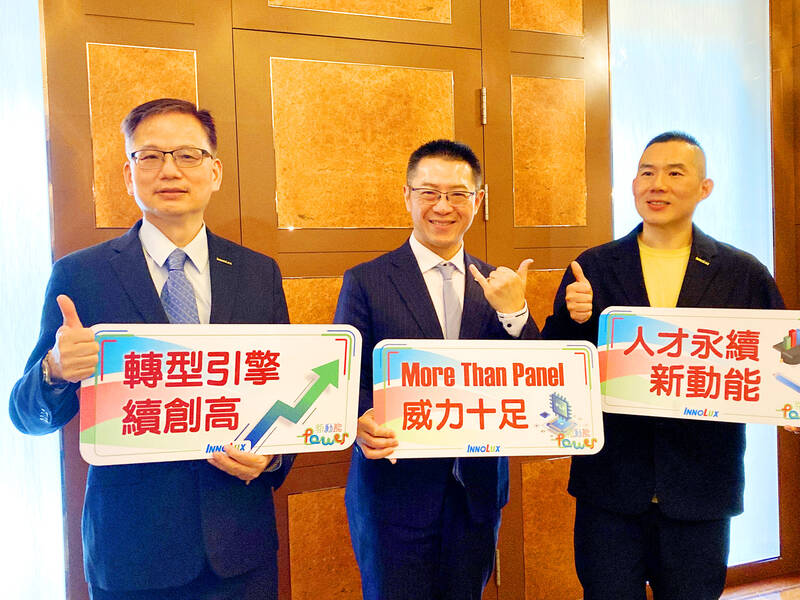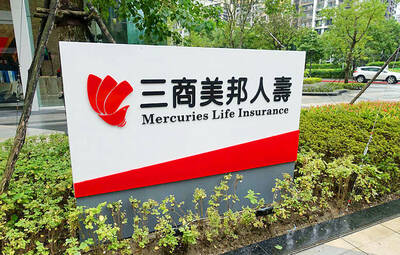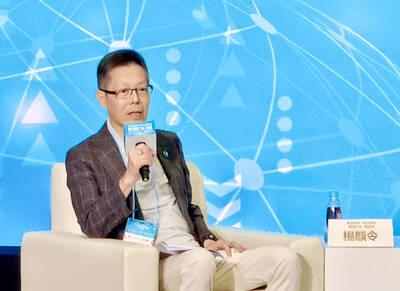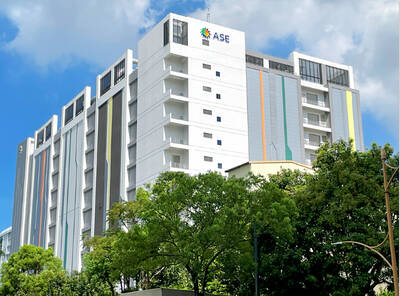Flat-panel display maker Innolux Corp (群創) yesterday said it is stepping up investment on developing panel-level packaging technologies, and that it plans to allocate more than 15 percent of its capital expenditures next year to the new semiconductor business.
This investment demonstrates Innolux’s determination to diversify from a pure flat-panel display manufacturer and to escape from the industry’s boom-and-bust cycles, the Miaoli-based company said.
The chip packaging business would play a vital role in the company’s transformation efforts, it said.

Photo: Lisa Wang, Taipei Times
This year, Innolux planned to spend about 15 percent of its annual capital expenditures, about NT$20 billion (US$612 million) or a little under that amount, on semiconductor-related technologies and equipment. About 85 percent would be allocated for its core display business, it said.
“In the long term, we hope for the semiconductor and display businesses to each account for half of the company’s total expenditures,” Innolux chairman Jim Hung (洪進揚) told reporters during an annual media event in Taipei yesterday.
“We intend to raise the portion of semiconductor investment each year,” Hung said.
Innolux’s entry into the semiconductor packaging sector has caught the attention of investors and semiconductor experts, as advanced packaging technologies are seen as potential solutions to extending Moore’s Law, when scaling technology reaches its physical limits. This is a reference to Intel co-founder Gordon Moore, who observed in 1965 that the number of transistors on an integrated circuit were doubling about every two years with minimal rise in cost.
Innolux’s aim is to create a new value-added business by leveraging its flat-panel display capacity and technologies. The first step is to revitalize a less advanced 3.5-generation flat panel fab and repurpose the glass substrates for chip packaging to create better value, since the fab is not cost-competitive, the company said.
The company originally planned to start shipping the first products using its first-generation panel level package (PLP) technology, called Chip-First technology, by the end of this year, it said, adding that it was targeting mid-to-low-end chips such as power ICs, or radio-frequency ICs, which are mostly used in smartphones and other consumer electronics.
However, a slump in smartphone demand stalled the company’s plan, Hung said.
Now, the company hopes to postpone the shipment until the first half of next year, when smartphone demand picks up a bit, he said.
Despite the setback, Innolux continues investing in second and third-generation PLP technologies, with the aim of progressing to mid-range and advanced chips.
To tap into silicon photonics, a new chip packaging technology, Innolux has acquired unspecified shares of two small-scale companies, BE Epitaxy Semiconductor Technology Co Ltd (元澄半導體科技) and Best Epitaxy Manufacturing Co Ltd (先發光電), it said.
Hung said that he had reached his turn-around goal for the company during his first 6-year tenure.
Innolux reported its second profitable quarter in a row, with profits of NT$421 million last quarter. In the first three quarters of this year, it accumulated losses of NT$2.55 billion, an improvement from losses of NT$15.4 billion during the same period last year.
Local rival AUO Corp (友達) has been in the red for the last 10 quarters. Losses have improved to NT$4.68 billion during the first three quarters, compared with losses of NT$16.69 billion a year ago.

AI BOOST: Although Taiwan’s reliance on Chinese rare earth elements is limited, it could face indirect impacts from supply issues and price volatility, an economist said DBS Bank Ltd (星展銀行) has sharply raised its forecast for Taiwan’s economic growth this year to 5.6 percent, citing stronger-than-expected exports and investment linked to artificial intelligence (AI), as it said that the current momentum could peak soon. The acceleration of the global AI race has fueled a surge in Taiwan’s AI-related capital spending and exports of information and communications technology (ICT) products, which have been key drivers of growth this year. “We have revised our GDP forecast for Taiwan upward to 5.6 percent from 4 percent, an upgrade that mainly reflects stronger-than-expected AI-related exports and investment in the third

Mercuries Life Insurance Co (三商美邦人壽) shares surged to a seven-month high this week after local media reported that E.Sun Financial Holding Co (玉山金控) had outbid CTBC Financial Holding Co (中信金控) in the financially strained insurer’s ongoing sale process. Shares of the mid-sized life insurer climbed 5.8 percent this week to NT$6.72, extending a nearly 18 percent rally over the past month, as investors bet on the likelihood of an impending takeover. The final round of bidding closed on Thursday, marking a critical step in the 32-year-old insurer’s search for a buyer after years of struggling to meet capital adequacy requirements. Local media reports

TECHNOLOGICAL RIVALRY: The artificial intelligence chip competition among multiple players would likely intensify over the next two years, a Quanta official said Quanta Computer Inc (廣達), which makes servers and laptops on a contract basis, yesterday said its shipments of artificial intelligence (AI) servers powered by Nvidia Corp’s GB300 chips have increased steadily since last month, should surpass those of the GB200 models this quarter. The production of GB300 servers has gone much more smoothly than that of the GB200, with shipments projected to increase sharply next month, Quanta executive vice president Mike Yang (楊麒令) said on the sidelines of a technology forum in Taipei. While orders for GB200 servers gradually decrease, the production transition between the two server models has been

ASE Technology Holding Co (日月光投控), the world’s largest integrated circuit (IC) packaging and testing supplier, yesterday announced a strategic collaboration with Analog Devices Inc (ADI), coupled with the signing of a binding memorandum of understanding. Under the agreement, ASE intends to purchase 100 percent shares of Analog Devices Sdn Bhd and acquire its manufacturing facility in Penang, Malaysia, a press release showed. The ADI Penang facility is located in the prime industrial hub of Bayan Lepas, with an area of over 680,000 square feet, it said. In addition, the two sides intend to enter into a long-term supply agreement for ASE to